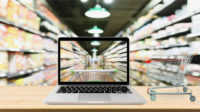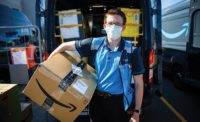2020 PREDICTIONS: E-COMMERCE
eCommerce Models, Strategies Continue to Quickly Evolve
Three trends are dramatically impacting the future path to market for food and beverage brands

By the end of 2021, an estimated 73% of eComm sales will take place on a mobile device. Technology is now a key component of the shopping experience.
PHOTO COURTESY OF: iSTOCK / GETTY IMAGES (WWW.GETTYIMAGES.COM)
In the world of eCommerce, there is never a pause from innovation and the unexpected. Moving into 2020, there are three trends, among many, dramatically impacting the future of food and beverage brands and their path to market.
The eCommerce Model is Not One Thing
Underscoring the importance of a true omni-channel strategy for both brands and retailers, Amazon announced the opening of a grocery store location in California—totally separate from Whole Foods and Amazon Go stores. The new store will focus on pick-up and delivery models that continue to emerge, though not without struggles.

Check out our December 2019 issue for more food & beverage predictions!
Amazon has undoubtedly honed knowledge of the grocery business with the acquisition of Whole Foods and I anticipate their new model will have broader selection for greater appeal to Amazon loyalists. This store will serve as a proving ground for more to come, signaling that now more than ever, grocery retailers must seriously get into the omni-channel game and brands can no longer look at grocery as a one-dimensional retail channel.
There’s no question that eCommerce models are evolving as third party marketplaces expand, offering brands the ability to sell their products online without directly selling to that retailer. More than 58% of products sold on Amazon in 2018 were sold through their third party marketplace and Walmart is rapidly expanding their owned eCommerce as well as marketplace. This creates an opportunity for new food and beverage brands to launch and live online months or years before leveraging their success onto brick and mortar retail shelves.
Consumer Buying Habits Change
Subscription is a way of life for online grocery shoppers, growing by more than 100% during the last five years (McKinsey, 2018) and prompting the need for brands to closely examine the products and pack sizes they sell online. In thriving categories such as coffee, snacks and household goods, subscription calls for a 30-60 day usage cadence, so a 12-pack of cereal is unlikely to meet consumer needs but an eComm-specific three-pack may.
Additionally, shoppers are paying attention to the environmental impact of packaging. If a product needs extra packaging to arrive intact to the consumer—unbroken, not leaking—engaging an eComm packaging expert is a smart investment to optimize product pack, minimize waste and reduce overall packaging costs long-term.
Food Meets Technology
Nielsen is forecasting that 70% of US shoppers could be buying groceries online by as early as 2022. By the end of 2021, 73% of eComm sales will take place on a mobile device (Statista, 2019). Technology is now a key component of the shopping experience.
No longer is getting your product online enough. Unicorn stories of viral success had their foundation in smart digital marketing tactics. Getting eyes on your products is essential or you are simply lost among millions, yet winning in digital has become complex.
Gone are the days when media campaigns can be managed manually. The metamorphosis of digital media technology continues and savvy use of automated tools will be essential for brands to win online.
Originally appeared in the December 2019 issue of Prepared Foods as More Clicks Than Bricks.
Looking for a reprint of this article?
From high-res PDFs to custom plaques, order your copy today!







